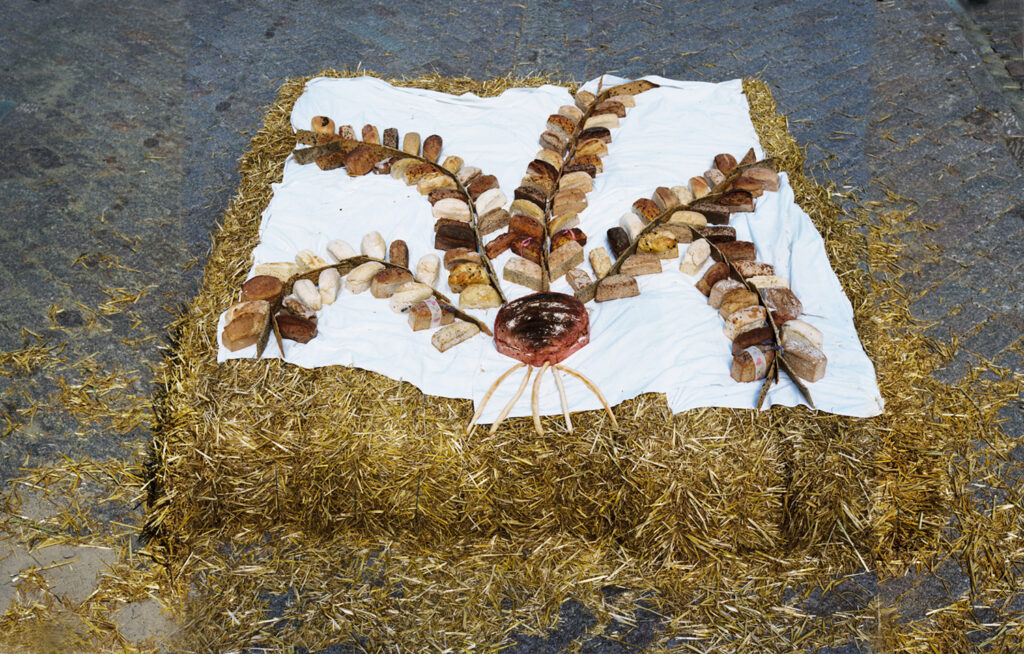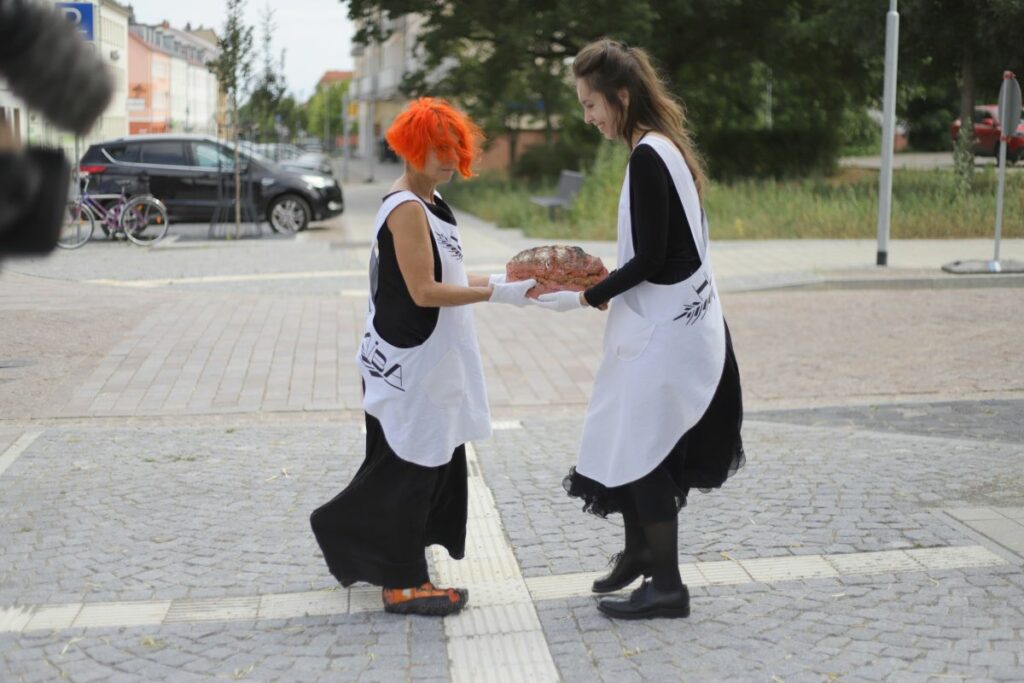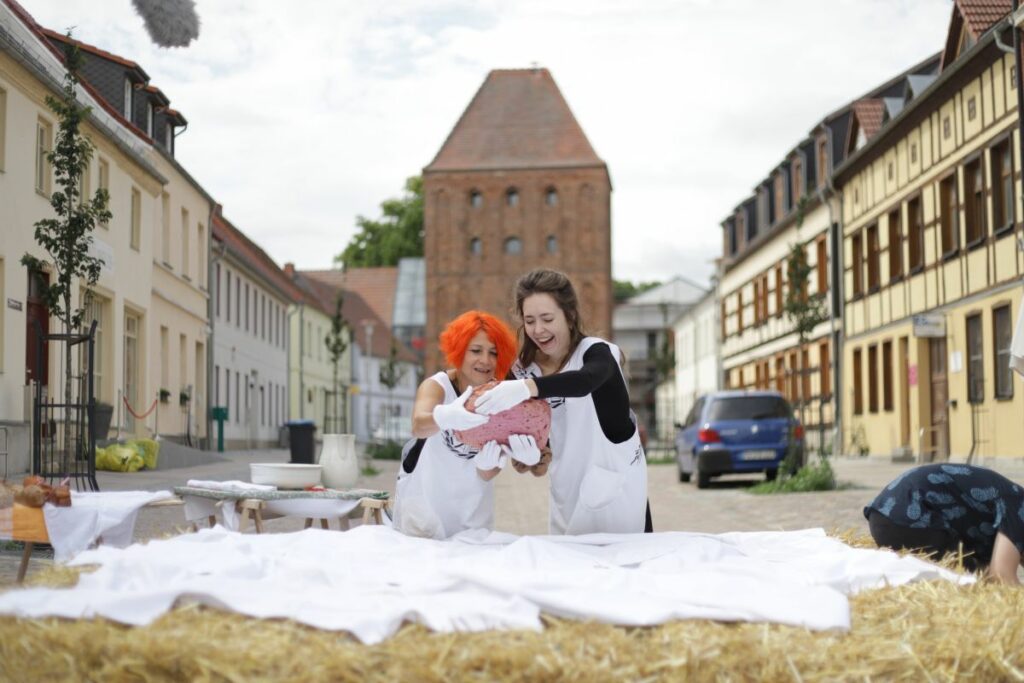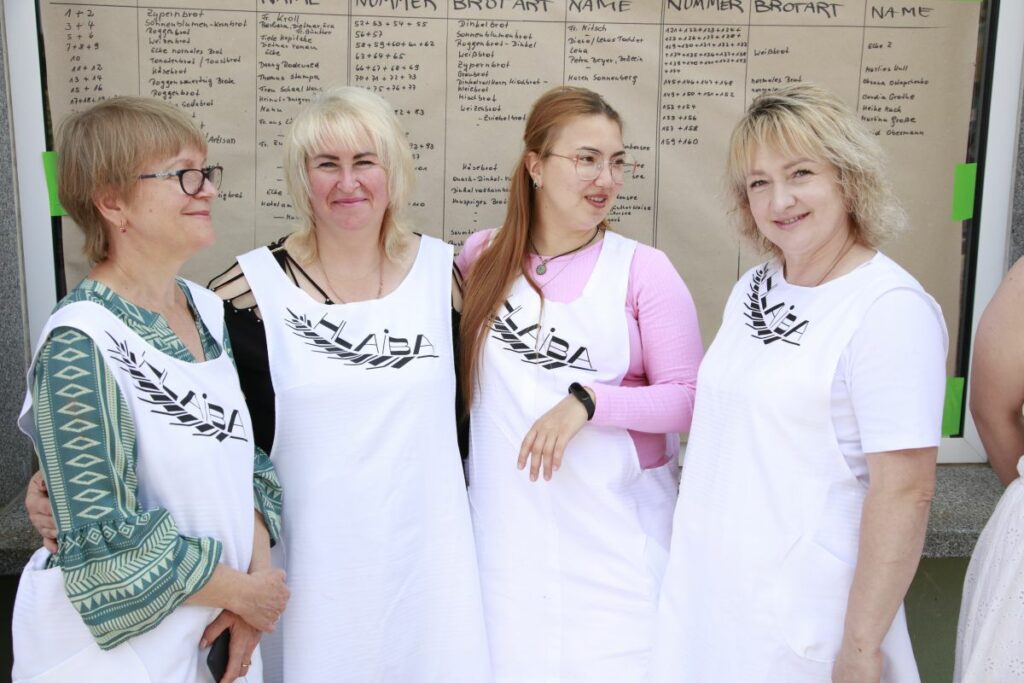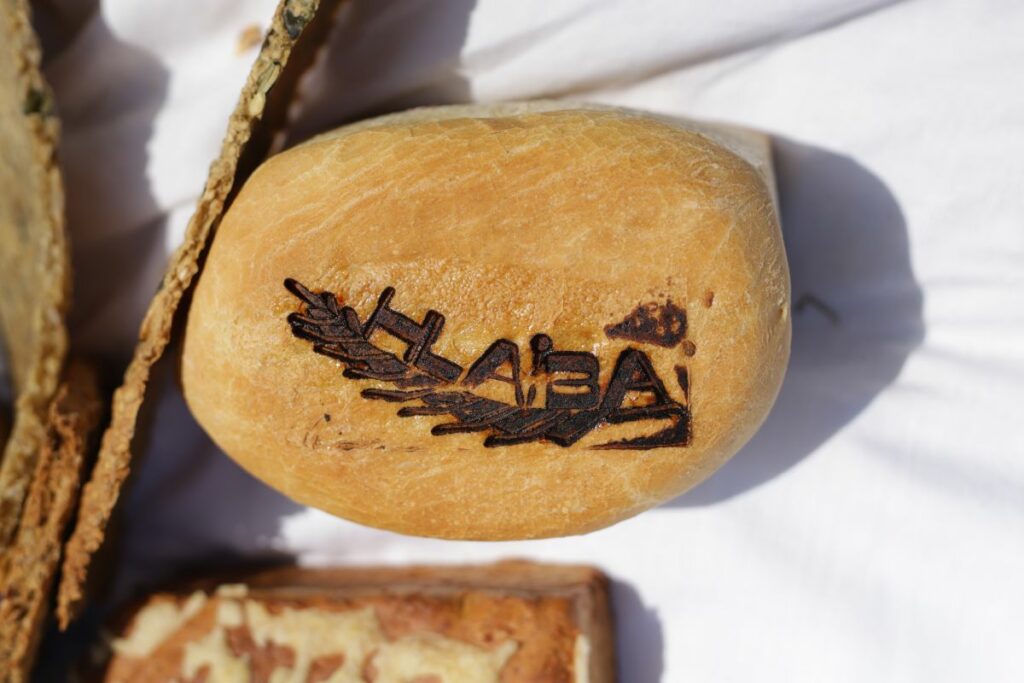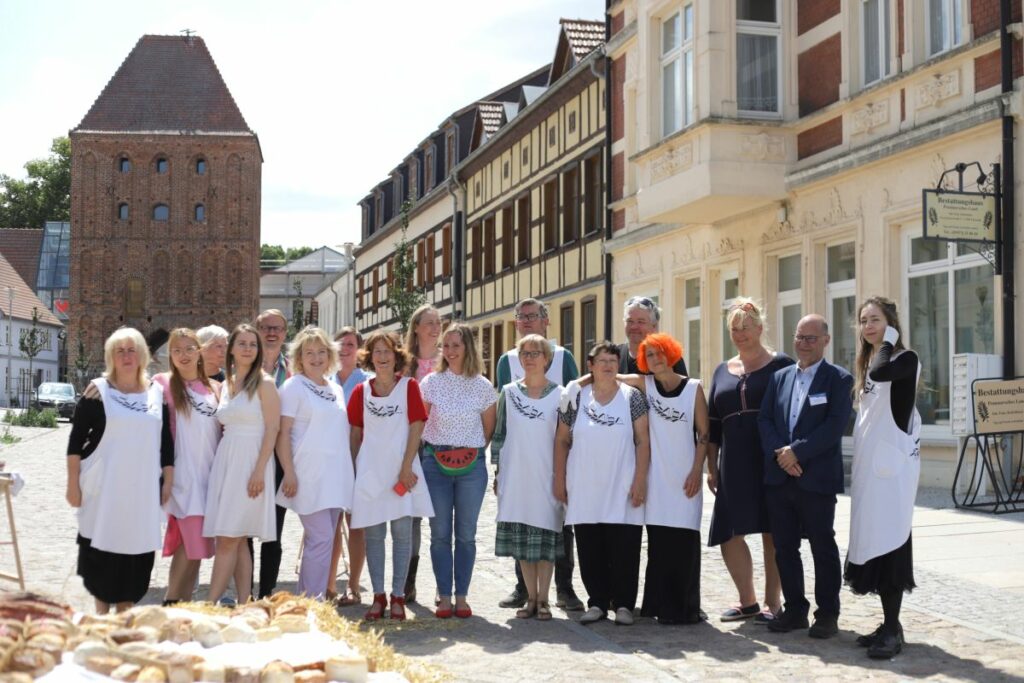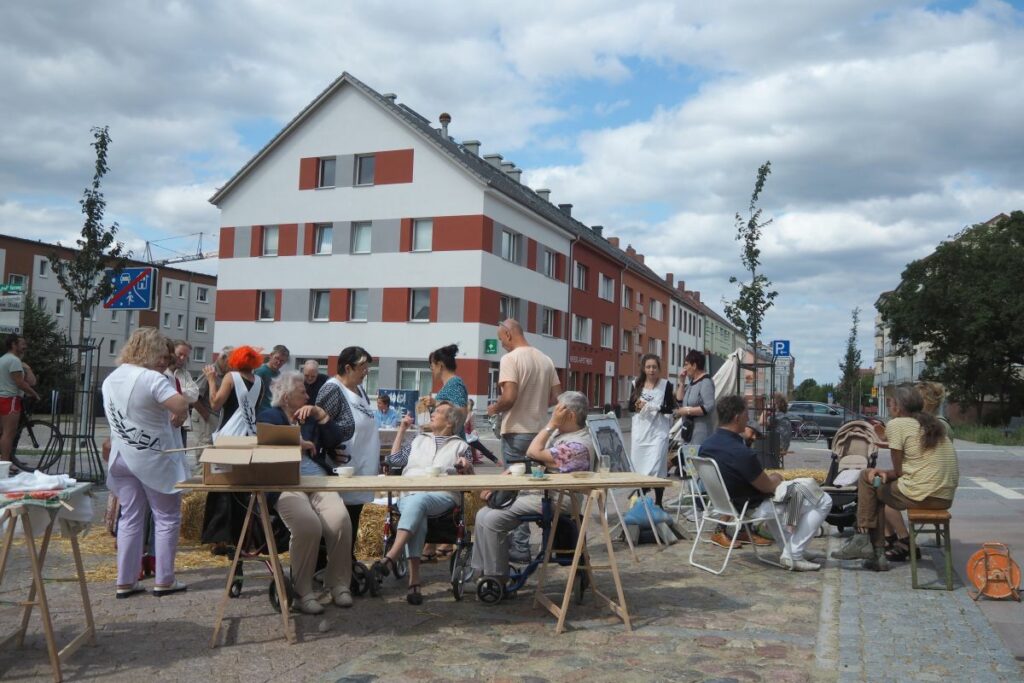The artistic work HLAIBA (from ancient engl. hlaf “loaf bread”) addresses how livelihoods are not only destroyed by tanks and howitzers in wartime, but how hunger has always been created as an existentially destructive, power-political instrument of warfare.
HLAIBA© Joachim Gern | to the right: Elke Wiese, Claudia Snow, Olena Moskovchenko, Lana Svirezheva, Liudmyla Dybka, Olena Kalinina, barbara caveng© Paolo Gallo


The starting point for the social bread work was an ear relief from the 1930s on a former granary in the town of Pasewalk in Mecklenburg/ Western Pomerania – a façade drawing made of brick and beaver tail that recalls Pasewalk as an agrarian town (Ackerbürgerstadt) and refers to the region’s importance as an agricultural location – until after the fall of the Wall.
the Deike-Winkelmann-granary at Pasewalk station | Poster HLAIBA ©bcaveng | Approach©Lana Svirezheva
The five ears of grain in the relief were recreated from 120 loaves of bread in a collaborative act by schriFTT:macherinnen barbara caveng and Lana Svirezheva together with residents of Pasewalk and the surrounding area, and presented by the Ladies Hlaiba* in a ceremony on July 23 and 24 at NUR KUNST in Große Kirchstraße 25/ Piazza Pasenelle.
All humans in the region were cordially invited to bake a loaf of bread for the work, which was dedicated to life in a community of solidarity.
All Fotos ©Joachim Gern und ©Paolo Gallo
In a process over several months, the Ladies and Lads Hlaiba, barbara caveng, Lana Svirezheva, Elke Wiese, Manuela Ammon, Claudia Snow, Larissa Soroko, Liudmyla Dybka, Oksana Moskovchenko, Lena Kalinina and Sebastian Arndt, as well as team members who wish to remain unnamed, had developed the work and brought it to completion.
160 loaves in the form of ear of corn were handed over to us within 48 hours. ‘No war for bread!’ – more than 100 people had taken up the idea and contributed their ear of corn bread to the social bread work, which stands for life in a society based on solidarity. The bakers came from near and far, from Pasewalk, the region, from other provinces within Germany, two of the breads were baked beyond the borders of the country. Among them were people who lived their lives in Pasewalk, those who came back and those who left the city, visitors, temporary residents, people for whom the place means shelter from war. The Ladies Hlaiba questioned prevailing power relations and sought a feminist counter-design as a more peaceful social vision.











Wheat bread, Cyprus bread, Irish soda bread, toast bread, tomato bread, corn bread, bread with kukuma and cranberries, sourdough breads … the baked ear of corn proved character and taste. The loaves promised pleasure and joy, some harbored pain and tears. On 23.7.2022 the ear of corn breads were joined to the remake of the relief at granary. The individual loaves could be purchased for donations. The proceeds were donated to the Taras Shevchenko University in Kiev to benefit students addicted by war.
The appearance of the bread sculpture underwent a constant change: loafs were tasted, handed over and their place in the relief were replaced by new ones – the last loaves were handed over to the visitors of the Volkssolidarität day care center, who had added jointly baked sunflower seed bread to the work.
 Heide-Lore Fritsch represented with her grain loaves the family history of the Deike-Winkelmann dynasty in the HLAIBA work . Heide-Lore is the granddaughter of Friedrich Herrmann Winkelmann and he, i.e. her grandfather, was co-owner of the Deike-Winkelmann company and co-architect of the granary, whose former significance and function is commemorated by the relief of ears of corn on the facade.
Heide-Lore Fritsch represented with her grain loaves the family history of the Deike-Winkelmann dynasty in the HLAIBA work . Heide-Lore is the granddaughter of Friedrich Herrmann Winkelmann and he, i.e. her grandfather, was co-owner of the Deike-Winkelmann company and co-architect of the granary, whose former significance and function is commemorated by the relief of ears of corn on the facade.
 In the immediate vicinity of the warehouse building rises a mighty silo, a white 80,000-ton grain palace built by VEB Fortschritt, a relic of a flourishing agricultural economy and a landmark of the city.
In the immediate vicinity of the warehouse building rises a mighty silo, a white 80,000-ton grain palace built by VEB Fortschritt, a relic of a flourishing agricultural economy and a landmark of the city.
Up to 400 tons of grain per hour were handled at VEB Getreidewirtschaft Pasewalk in GDR times. After reunification, the former nationally owned company became the property of the HaGe Group and is now of little significance to the working lives of local people. Its silhouette – life cast in concrete, memory stored in eight tubes. The majority of flour mills in the region have also long since been shut down, turned into museums or restaurants.
“Bread is the head of everything” – Ukrainian proverb
20 million tons of grain are stored in Ukrainian granaries, the media report. Enough to save the world from what was looming in springtime of 2022: a famine that drastically exacerbated the existing plight of millions who do not have enough to eat. Yemen, Chad, Somalia, Lebanon…. Every day, more countries came into focus whose inhabitants were or still are threatened by starvation.
Holodomor– death by starvation for economic interests – between 3 and 7 million* people starved to death during the forced industrialization of agriculture carried out by the Soviet Union in the Ukrainian Soviet Republic in the 1930s. The bouquet of five ears of corn evokes different assosiactions: “We remember the Holodomor and the infamous ‘law of five ears of corn’. This law became a harbinger of the Holodomor. It provided for the theft of collective farm property by execution on the spot and confiscation of the property. This is shocking, but even a few spikelets wintering in the field under the snow were considered such property.” Words of Maryna Bielinska, psychologist from Kiev, on 23.5.2022 in a written exchange about the project ‘Hlaiba’.
WARBREAD -WARBREAD
BREAD NOURISHES THE BODY AND BOOKS NOURISH THE MIND. Alongside the bread work HLAIBA, which invites an examination of the question of how we deal with food, the work WARBREAD was created in collaboration with lecturers and students of the Taras Shevchenko National University of Kyiv, asking about the meaning of spiritual nourishment in the form of literature and poetry. The installation WARBREAD was shown for the first time at the Museum Brot und Kunst, Ulm from July to September 2022…
In the collection “Contributions to the History of Pasewalk” from 1988 one can find a poem by Elisabeth Haase. It reads as if she had just written it…
*Ladies HLAIBA refers to the original meaning of the word as read in the Wahrig dictionary:
*Lady in England: title for noble woman, also general: lady.
English lady, from Mengl. lafdi, lavede, from Old English hlæfdige “lady of the house”, proper “bread maker”, from Old English hlaf “loaf of bread” (to Goth. hlaifs, Old Norse hleifr “loaf of bread”) and Old Norse dige “maid” (who is responsible for making dough, to Goth. digan “to knead”).
HLAIBA is part of the artistic-participatory research project schriFTTmacher:innen, realized between February and August 2022 in the context of a artists residence in Pasewalk Mecklenburg-Vorpommern. barbara caveng was artistically accompanied by the painter Lana Svirezheva.
The pilot residence was funded by the Kulturlandbuero Uecker-Randow and supported by the City of Pasewalk and the Museum of the City of Pasewalk.
The Kulturlandbüro is funded in TRAFO – Models for Culture in Transition, an initiative of the German Federal Cultural Foundation, and with funds from the Ministry of Education, Science and Culture of Mecklenburg-Vorpommern, the Vorpommern Fund – Parliamentary State Secretary for Vorpommern, the County of Vorpommern-Greifswald, the Ostdeutsche Sparkassenstiftung and the Sparkasse Uecker-Randow.





